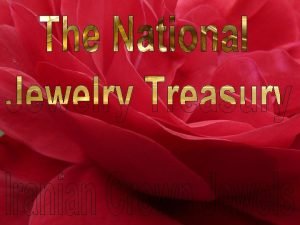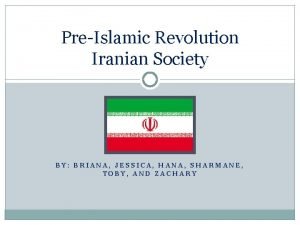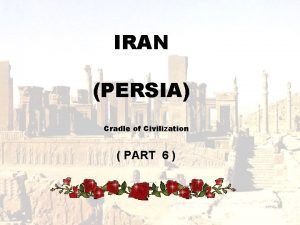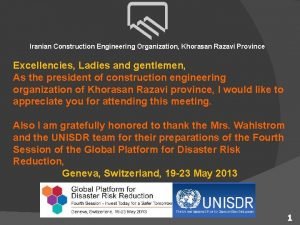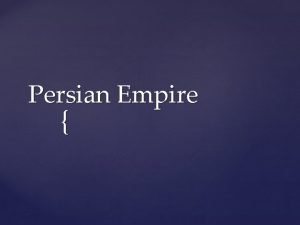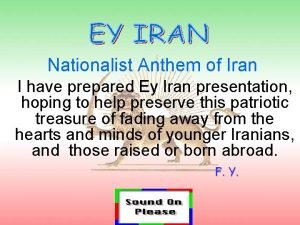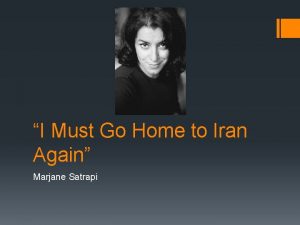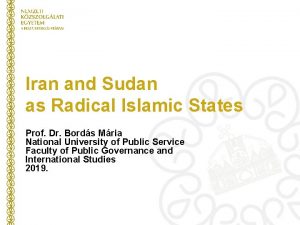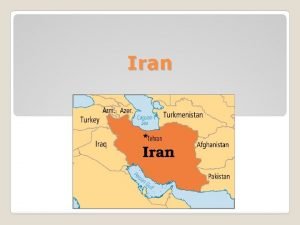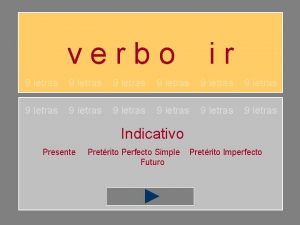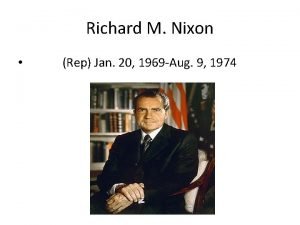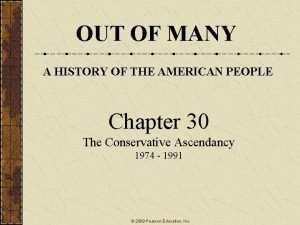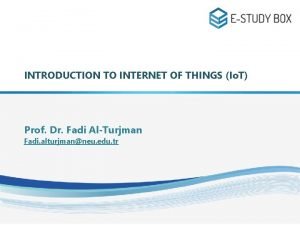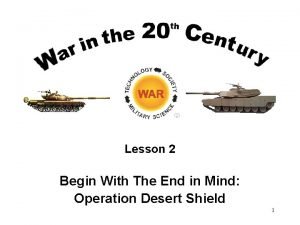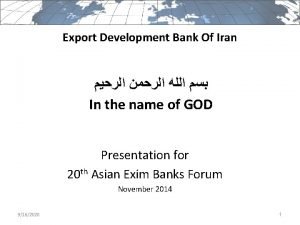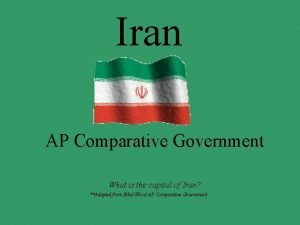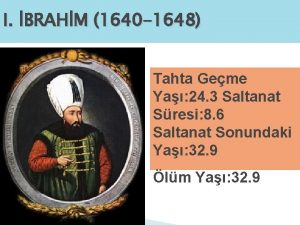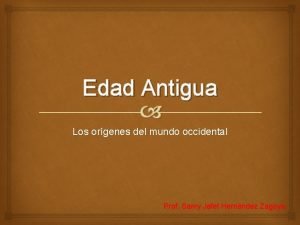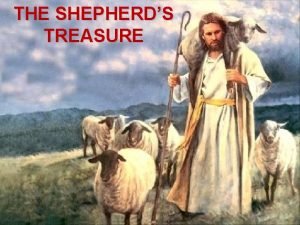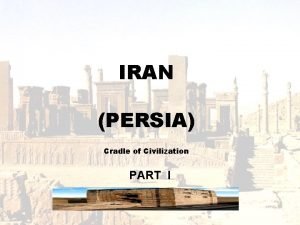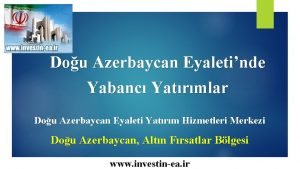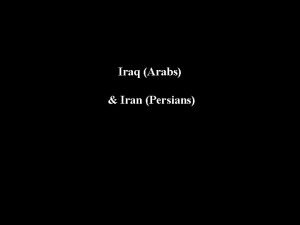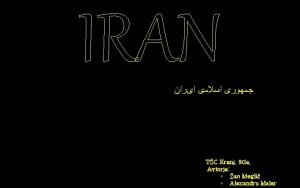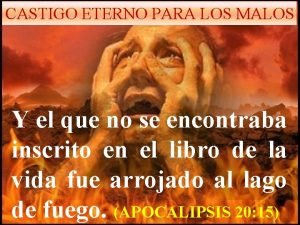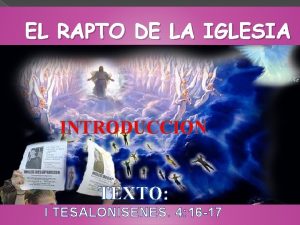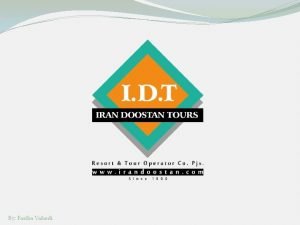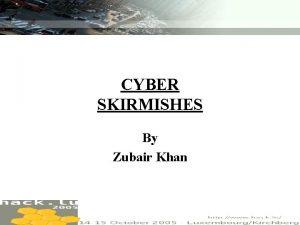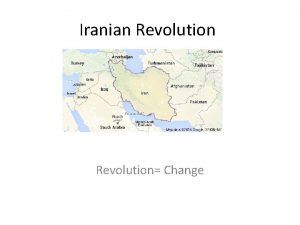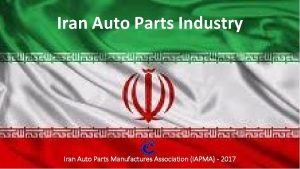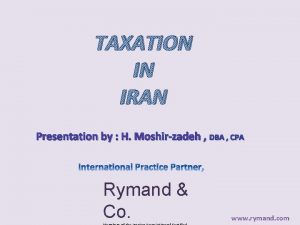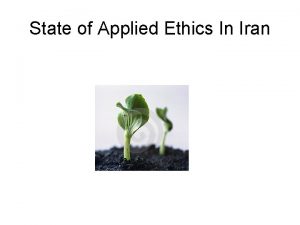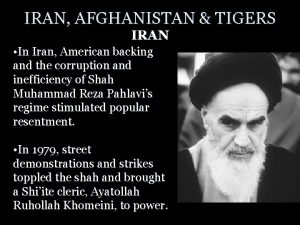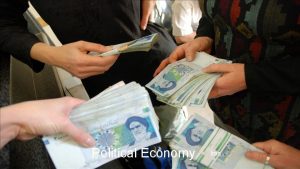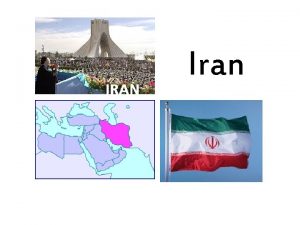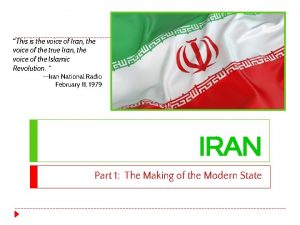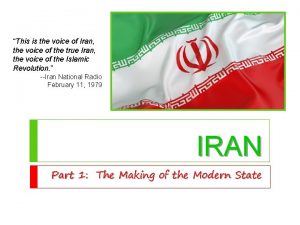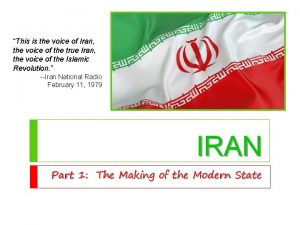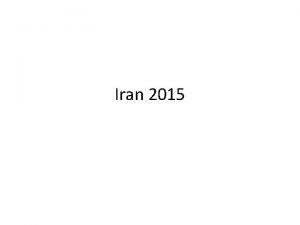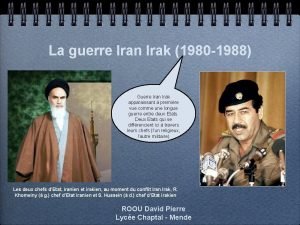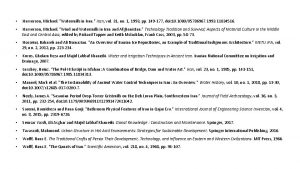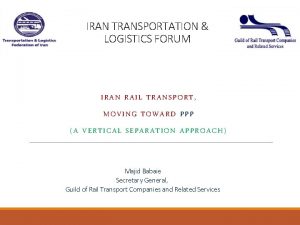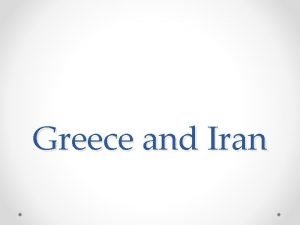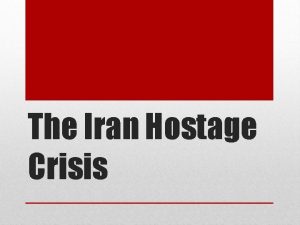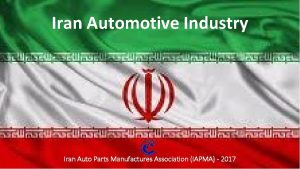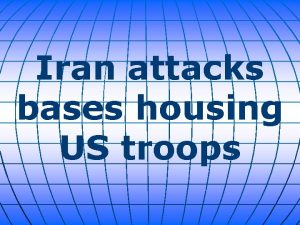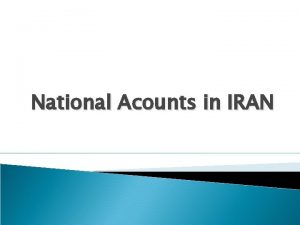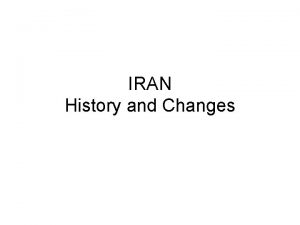This is the voice of Iran the voice

































- Slides: 33

“This is the voice of Iran, the voice of the true Iran, the voice of the Islamic Revolution. ” --Iran National Radio February 11, 1979 IRAN Part 1: The Making of the Modern State

Iranian Flag and National Anthem � Iranian Flag: Green = Islam/Persia � White = Freedom/Purity � Red = Sacrifice/Martyrs � The center symbol is a calligraphic Arabic word design in the Flag center that could either be read as Allah (GOD) and or Laelaha Ellallah (there is no God but one almighty God). The five parts symbolize the five pillars of Islam. The sword represents the strength of Iran and the “tashdid” on top doubles that power. � � Symbolism � = A tulip growing from the blood of martyrs. The border on the red and green middle section is a stylized Arabic script of “Allahu Akbar” meaning “God is greater than to be described. ” � National Anthem:

Why Study Iran? � World’s only theocratic republic � Theocracy with democratic elements � Unique among Middle Eastern countries � Tradition versus modernization

Geography � Crossroads between: Central Asia and Asia Minor � Indian subcontinent and the Middle East � Arabian Peninsula and the Caucasus Mountains � � Historically vulnerable to invaders � 3 x the size of France � Much of territory inhospitable to agriculture � 2 nd largest oil producer in the Middle East and 4 th largest in the world � Urbanized and party industrialized 68% live in urban centers � 70% labor force is employed in industry and services �

Population � 67% of population on 27% of land � � Mostly in the NW and cities of Tehran, Qom, Isfahan, Shiraz, & Ahwaz Persian country, NOT Arab � Strong sense of nationalism – Identify as Persian before Muslim 89% Shi’a Muslim � 58% speak Farsi (Persian) � � � Recent years, successful literacy campaign Over 90% of population can now communicate in Persian, the national language

Population � Iran has a large young population � 24% of all Iranians are under 15 and 27 is median age (was 23!)

Population and Statistics � Youngest population of the AP 6 � After 1979 Revolution, government encouraged births to produce soldiers for the war against Iraq � Then, it encouraged birth control � Even had a state-owned condom factory! (b/c economy could not support rapidly growing population) � The government is made up of mostly the older generation � 83% of adults are literate, life expectancy is over 70 � Middle income country with per capita income above that of Mexico, Brazil, and South Africa


Population � Discussion Question: What future problems might be Iran need to address based on this population pyramid? Why is Iran now promoting population growth?

Sunni v. Shiite Sunnis Shiites Majority of population in most Muslim countries Majority in Iran, Iraq, Bahrain, possibly Lebanon “Followers of tradition” “Partisans of Ali (son-in-law)” Most prominent members of community should select new leader, 4 caliphs (and heirs), based on piety, wisdom, morality, leadership ability, competence; ruled continuously until breakup of Ottoman Empire at end of WWI Leadership should be based on bloodlines to Muhammad…all the way to Twelfth (Hidden) Imam who went into hiding; his return will herald end of the world Any religious educated person can rule Senior clerical scholars (ayatollahs) should interpret Shari’a until Twelfth Imam returns Overwhelming majority in world Less than 10% of Muslims worldwide -See themselves as “party of oppressed”

History – Safavids & Qajars � Safavids � (1501 -1722) conquered Iran in 16 th century Forcibly converted their subjects to Shi’ism � Sunni population remained on periphery � Rulers claimed to be descendants of 12 Imams Imam: a Muslim leader of the line of Ali held by Shiites to be the divinely appointed, sinless, infallible successors of Muhammad � Tolerated Christians, Jews, Zoroastrians � Qajars � religious minorities (1794 -1925) A Turkish tribe takes power after invasion and civil war � Did not claim hereditary links to 12 Imams Move capital to Tehran � Declared Shi’ism to be state religion; clerical leaders’ interpreters � Economic troubles during time of imperialism � � Iran was never colonized, but imperialist nations (GB, Russia) gained concessions

History – Introduction of Democracy � Constitutional Revolution (1905 -1909) Merchants and local industrialists demanded constitution � Shah (king) agreed � � Constitution of 1906 Direct elections � Separation of powers � Laws made by elected legislature (Majles) � � Very strong – controlled cabinet members Popular sovereignty � Bill of Rights � Retained Shiism as official religion � Created Guardian Council of clerics � � Veto power

History – The Pahlavi Dynasty (19251979) � 1921 - Reza Shah carried out coup d’etat Military officer � Abolished Qajar dynasty � � 4 years later named himself “shah-in-shah” (king of kings) Ruled with iron fist; Majles lost its power � Created centralized bureaucratic state by modernizing economy and secularizing political life of the country (built first national railroads, first modern factories, and took land from rural elites) � � Women did not have to wear veil � Men had to shave their beards � Closed religious schools � Replaced with free, state-run institutions that stressed science and other modern topics Changed name from Persia to Iran; allied with Nazis � Forced to abdicate in 1941 because of his pro-German sympathies

History – The Pahlavi Dynasty (1925 - 1979) � Reza’s son, Muhammad Reza Shah took power in 1941 � Formed SAVAK: secret police � Arrested, tortured, killed dissidents at home and abroad � Authoritarian regime � Centralized power (e. g. , Interior Ministry appointed provincial governors, town mayors, district superintendents and village headmen) � Built up military – 5 th largest in world by 1979 � Secularized legal system (supplanted shari’a) � Close ally with United States (puppet) � Improved infrastructure � Rise of the National Front (opposition) � Led by Muhammad Mosaddeq � Drew support from middle class

History – The 1953 Coup � Mosaddeq advocated nationalizing the British owned-company that monopolized Iran’s oil business � British establish the Anglo-Iranian Oil Company (later = BP) � Supported by Tudeh – Communisty Party � Also wanted to take armed forces out from under shah’s control � Elected Prime Minister in 1951 � Power grew & forced shah to flee country in 1953 � British and U. S. orchestrated overthrow of Mosaddeq & restored shah to power…Why?

History – Muhammad Reza Shah �Westernization/Secularization �White of Iranian culture Revolution (1963): Focused on land reform Gov’t bought land from large absentee owners and sold it to small farmers at affordable prices Purpose was to encourage farmers to become entrepreneurs with irrigation canals, dams, and tractors Secularized Iran further by extending voting rights to women, restricting polygamy, and allowing women to work outside the home Called “white” to counter “red” influences

History – Muhammad Reza Shah � Rentier state - Derives much of its revenue on a regular basis from payments by foreign countries in the form of “rent” Rentier economy is heavily supported by state expenditure, while the state continuously receives “rent” from abroad � Iran received an increasing amount of income by exporting its oil � � Income so great that by 1970 s govt no longer relied on internal taxes for support � Paid most of its expenses through oil income � Import-substitution placed emphasis on capital-intensive industries and led to neglect of small-scale production and agriculture � Industrialization � Rapidly industrialized from oil revenue � Centralization � State controlled – banks, tv/radio, Natl. Iranian Oil Co. ; local gov’t came under control; Majles became a “rubber stamp”

History – Muhammad Reza Shah � Discussion Question: Can a government that doesn't depend upon its constituents for income (rentier state) really be representative or legitimate?

History – Muhammad Reza Shah � The Shah’s Downfall: Became more distant from people over the years � Became very wealthy � � Bolstered personal wealth by establishing -exempt Pahlavi Foundation, a patronage system that controlled large companies that fed the pocketbooks of the shah and his supporters tax Ignored civil liberties � Stifled newspapers, political parties, and professional associations � � 1975 – Shah announced the formation of the Resurgence Party and declared Iran to be a one-party state with himself has the head � Alienated clergy, intelligentsia, and urbanites � Overstepped bounds of political culture: Perceived as being totalitarian � Secularized too fast � Offended nationalists and clergy with ties to west (particularly U. S. ) �

Comparative Iranian Regimes Rulers Characteristics Influences on Modern Political System Safavids (15011722) Converted Iranians to Shiism Tolerated “People of the Book” Ruled from Isfahan Relied on local rulers Rulers claimed to be descendants of the 12 Imams Almost 90% of Iranians today are Shiite Tradition of isolation Authoritarianism, NOT totalitarianism Foundations for Theocracy Qajars (17941925) Turkish invaders Ruled from Tehran Retained Shiism, but lost hereditary claims to 12 Imams Dominated by other countries Loved luxury; fell into debt Loosened Shiite influence Tradition of trade/contact with others Authoritarianism, NOT totalitarianism Foundations for secularism, separation btwn religious and political leaders Failures of regime led to the creation of a repressive government Pahlavis (19251979) Overthrew representative govt Centralized power in shah Increasing oil income: rentier state Contact with West Reinforced authoritarian rule; led to resistance to totalitarianism Modern corruption issues in govt, economy Increased secularization led to re-

History – 1979 Revolution � Triggers: Oil prices decreased by 10% and consumer prices increased 20% � Revolution of rising expectations � U. S. put pressure on shah to loosen restraints on opposition � � Encouraged others to voice frustrations � Organized sectors � and led by clerics, but broadly supported by many Revolutionary coalition: Urban poor (especially recent rural-urban immigrants) � Moderate middle classes, concerned with political freedoms � Leftists � Bazaar merchants: ability to bring economy to standstill � Clergy: moral focal point, and hierarchical internal structure, communication networks, capable orators � � Charismatic Khomeini � leader – Ayatollah Ruhollah In exile in Paris, but speeches were influential � Shah fled country in Feb 1979

Founding of the Islamic Republic - 1979 � April 1979 national referendum was held – voted out monarchy established Islamic Republic � Established a new constitution Drawn up by Assembly of Religious Experts (73 man assembly of clerics directly elected by people) � Gave broad authority to Khomeini and clergy, although PM Mehdi Bazargan strongly objected � Presented to people in midst of U. S. hostage crisis – high hostility toward Americans – 99% of electorate endorsed (only 75% voted) � � Ayatollah Khomeini (Supreme Leader) � Islamic fundamentalism Emphasized literal interpretation of Islamic texts � Social conservatism � Political traditionalism � � Jurist’s � guardianship (valeyat-e-faqih): Gave senior clergy (Grand ayatollahs) all-encompassing authority over the whole community—not just widows, minors, and mentally disabled � Only senior clerics could interpret Shari’a Law

Iran Hostage Crisis � American embassy hostages held for 444 days from 1979 - 1981 � Believed that purpose could be to undercut PM Bazargan � � Official prime minister of provisional government at the time of the Revolution Islamic in name but democratic in content Wanted to call Iran Democratic Islamic Republic Resigned when he realized that Khomeini would not order the release of the hostages

Cultural Revolution � Launched by Shia leaders after revolution � Aimed to purify the country from the shah’s regime, secular values, and western influences � Purged universities of liberals � Suppressed all opposition � Similar to? ?

Iran-Iraq War (1980 -88) � Started � when Iraq invaded Iran by land air U. S. backed Saddam Hussein and Iraq – provided weapons � People rallied around the govt in response � Ended in 1988 with a UN-brokered cease-fire

Post-Khomeini (1989 -Present) � Khomeini � died in 1989 The Constitution specifically put Khomeini in the position for life, and stated that after his death, his authority would pass to a leadership council of two or three senior clerics � This did not occur when Khomeini died b/c his followers did not trust the clerics � Ayatollah Ali Khamenei (1989 -Present) Change in constitution � A Cleric of middle rank � Does not have same charisma or academic credentials � Keeps spirit of revolution alive, -American, and maintain theocracy � � President anti - Hashemi Rafsanjani (1989 -1997) � Moderate � Concerned with reforming slumping economy due to theological commitments and war with Iraq � Very few reforms

Post-Khomeini (1989 -Present) � President � Mohammad Khatami (1997 -2005) Reformist and surprise winner Vote from women, university students, and young adults throughout country, even those in armed forces � Originally seen as major setback for conservative clergy � Campaigned on theme of creating “civil society” and improving sick economy � � Reforms: Easier to organize political groups � Less censorship of press � Some open protests permitted � Relaxed enforcements of social interactions between sexes � Allowed inspections of nuclear facilities � Tried to improve relations with US and other Western countries � � Reformist Khatami was left isolated by conservative resurgence � � � Most reforms overturned by Guardian Council Hard line conservatives disqualified moderates from 2004 parliamentary elections

President Ahmadinejad (2005 -2013) � President Mahmoud Ahmadinejad (2005 -2013) � Tehran's ultra-conservative mayor � Won a run-off vote in presidential elections in June 2005, defeating his rival, the former president Akbar Hashemi Rafsanjani � First non-cleric president in 24 years

2009 Presidential Election � Huge push for reformist candidate Mousavi to beat Ahmadinejad � Close race – 85% Turnout � Allegations of fraud were strong – Mousavi urged his supporters to the streets The Iranian government itself has acknowledged that in 50 areas, more votes were counted than there are eligible voters � The government has acknowledged that 3 million ballots were stuffed � � Khamenei � agreed to an investigation Iran's supreme leader, Ayatollah Khamenei, declared the vote legitimate � Huge protests/Government Crackdown Dozens of moderate clerics and reformist political leaders in Tehran and around Iran arrested � Mousavi himself was "being closely monitored by police" � Ayatollah Khameni has restated his position that the election results were fair � Significant violence at universities around the country, as well as �


President Ahmadinejad (2005 -2013) � Council of Guardians rejected candidacies of popular reformers � Further restrict public freedom � Several major reformist newspapers closed � Journalists and civil society activists arrested � Jailed internet users who spread information “aimed at disturbing the public mind” � Morality police and vigilantes to enforce Islamic dress codes & prevent public mingling of men and women � Increased reports of arrest, torture, and executions � Sharia more strictly enforced � Called for destruction of Israel � Questioned reality of Holocaust � Increased nuclear fuel research

Current � President Rouhani (Elected 2013) � Moderate cleric � How did he win? � Guardian Former President – Rafsanjani Ahmadinejad’s choice – Esfandiar Rahim Mashaei � High Council disqualified two prominent candidates turnout – 72% Rouhani – 50. 7% � What does this mean? � Powerful mandate to improve international relations � Negotiate nuclear settlement � Helped Supreme Leader: Restored legitimacy lost after 2009 election Returned a cleric to the presidency Ahmadinejad often clashed with the religious order and traditionalists

Review: Crash Course
 The voice iran
The voice iran Persian crown jewels
Persian crown jewels Jessica hana
Jessica hana Abdollah arefkia
Abdollah arefkia Local guide program
Local guide program Satrapy of iran
Satrapy of iran Ey iran national anthem
Ey iran national anthem I must go home to iran again
I must go home to iran again Mosadek iran
Mosadek iran Persia before 1935
Persia before 1935 Yo en presente pasado y futuro
Yo en presente pasado y futuro Iran contra affair
Iran contra affair Oliver north iran contra affair
Oliver north iran contra affair Iot iran
Iot iran Razboiul iran irak
Razboiul iran irak Iran hostage crisis timeline
Iran hostage crisis timeline Export development bank of iran
Export development bank of iran Capitalof iran
Capitalof iran Iran'la sınırımızı belirleyen antlaşma
Iran'la sınırımızı belirleyen antlaşma Iran
Iran Shepherd's treasure
Shepherd's treasure Ey iran lyrics farsi
Ey iran lyrics farsi Language in iran
Language in iran Azerbaycan yüzölçümü
Azerbaycan yüzölçümü Iran
Iran Iran prebivalstvo
Iran prebivalstvo Dios castiga a los malos
Dios castiga a los malos Alabanza el rapto de la iglesia
Alabanza el rapto de la iglesia Doostan chat
Doostan chat Oliver north iran contra affair
Oliver north iran contra affair Iran cyber
Iran cyber Savak iran
Savak iran Plastic omnium h300
Plastic omnium h300 Dba iran
Dba iran

